
What is Von Recklinghausen disease?
Von Recklinghausen disease or also called neurofibromatosis type 1, is a severe hereditary disease that affects several organ systems, but especially the nervous system and the skin. Doctors classify the disease as one of the so-called phakomatoses. These are clinical pictures in which mostly benign tumours of the skin and the nervous system are formed. However, Von Recklinghausen's disease is also causative for changes in the vessels of the skin, the brain, the eyes and the bones.
What causes Von Recklinghausen's disease?
The cause of this disease is the genes. In affected patients, the so-called NF1 gene is mutated. This gene is actually responsible for the production of neurofibromin, which is responsible for suppressing certain tumours or their development and thus preventing them. However, this important protective effect is lost due to the defective gene. In about 50 % of cases, the parents have passed on this genetic defect to their children. In the other 50 %, the Von Recklinghausen disease resulted from a spontaneous mutation of the genetic material.
What are the symptoms of Von Recklinghausen disease?
A particularly typical symptom of neurofibromatosis type 1 are skin nodules, that form. At first they are isolated, but later they become more and more numerous . These neurofibromas develop where the nerves run through the skin . Their appearance is mostly widespread and pedunculated and the trunk is particularly affected. The neurofibromas are either on the surface of the skin or can also be felt in the subcutis. A further indication of Von Recklinghausen's disease are pigment spots, also called café-au-lait spots. These skin spots also occur in healthy people, but in the case of neurofibromatosis, they are much larger and more numerous. The superficial patches do not usually cause symptoms or discomfort, but they can be very distressing for a patient from a cosmetic point of view .
Other possible symptoms include the following:
- Bone changes such as bone fractures, bone cysts, deformations or adhesions of vertebrae, spinal curvature and deformations of the skull bone,
- Eye changes such as reduced vision if the tumour is located along the optic nerve. The iris shows yellow-brown and roundish changes,
- premature onset of puberty,
- Hypertension and abnormalities of blood vessels,
- Hyperactivity, ADHD.
How is Von Recklinghausen's disease diagnosed?
In order for a doctor to make the diagnosis of neurofibromatosis type 1, he will first take the patient's medical history in detail. If the disease occurs frequently in the family, this is already a clear sign. The characteristic changes in the skin also suggest the suspicion. The doctor will primarily examine the skin, the eyes and the skeleton greenish. A tissue sample is essential so that the neurofibromas can be clearly identified. This is then examined in the laboratory for fine tissue. The skin tumours, which cannot be seen from the outside, can be visualised with the help of an MRI.
Von Recklinghausen's disease is diagnosed according to the following criteria:
- There are six or more café-au-lait spots on the skin that are at least five millimetres in size.
- Two or more neurofibromas are present.
- The doctor recognises two or more blotchy changes in the iris when examining the eyes.
- It is certain that first-degree relatives suffer from Von Recklinghausen disease.
- Certain bone changes are found on examination of the skeleton.
If two or even more of these criteria are present, Von Recklinghausen disease is considered confirmed.
How is Von Recklinghausen's disease treated?
neurofibromatosis type 1 is a hereditary disease, for this reason there is currently no treatment for the causes and the disease cannot be cured. However, it is possible to alleviate the symptoms and discomfort of neurofibromatosis type 1. During an operation with a laser or scalpel, it is possible to remove the neurofibromas, which are very troublesome, especially because they are cosmetic, or which also cause discomfort. There is also the drug Selumetinib, which is approved in Europe and is available for people with neurofibromatosis type 1. The active ingredient contained in is supposed to ensure that the tumours do not grow further or even shrink .
What is the prognosis for Von Recklinghausen's disease?
The prognosis depends mainly on the individual course of the disease. If the disease is limited to changes in the skin , the prognosis is favourable. However, the prognosis worsens if malignant tumours develop from the neurofibromas. In such a case, as with other types of cancer, it is crucial that the tumour can be detected and treated early. Basically, it can be said that the life expectancy of people with Von Recklinghausen's disease is reduced by about 15 years.
How can Von Recklinghausen's disease be detected early in children?
In babies, café-au-lait spots are usually the first to appear, even in the first weeks of life . In babies and toddlers, neurofibromas are rather rare. Sometimes, abnormalities can already be seen in the area of the face. Due to a so-called wedge leg dysplasia, the eyes of affected persons protrude and shift. The changes in the nervous system can lead to developmental disorders and thus speech and motor skills develop more slowly. In addition, learning ability and attention can be significantly impaired in some affected children. Even physical clumsiness, behavioural problems and restrictions in social behaviour can be symptoms of Von Recklinghausen disease in children. The head of a sick child also grows faster in many cases, which can lead to vomiting and headaches.
